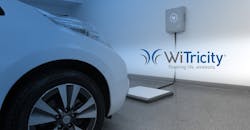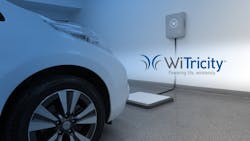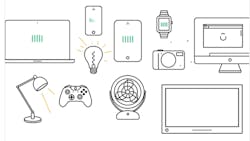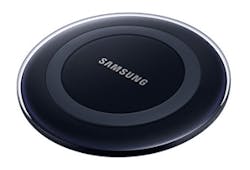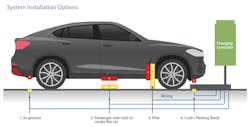The transmission of wireless energy was an idea born over 100 years ago by famed inventor Nikola Tesla. Although he was successful (albeit limited) in seeing his vision become a reality with the Tesla Coil, the technology never went mainstream and ultimately fell into novelty and obscurity. A century later, the technology has resurfaced and been developed for the consumer market in both small- and large-scale form.
Most wireless power and charging platforms utilize time-varying electric, magnetic, or electromagnetic fields to transmit power, and can be broken down into two categories: non-radiative and radiative or near and far field. The former transfers power over short distances using inductive coupling between two wire coils, or electric fields using capacitive coupling in between a pair of electrodes. This platform is most notably used for recharging mobile devices and other applications where distance isn’t a factor.
Radiative, on the other hand, beams power over long distances via beams of electromagnetic radiation, utilizing microwaves or lasers to power everything from wireless drones to solar-powered satellites. This roundup will focus mainly on near-field wireless-charging technologies, their respective applications, and what the future holds for wireless power.
1. WiTricity
(Image credit: WiTricity via Twitter)
Boston-based startup WiTricity is known for its “magnetic resonance” wireless-charging technology, which is based on weakly coupled electromagnetic resonant objects to transmit power. The firm’s platform consists of transmitters and receivers that house magnetic loop antennas tuned to the same frequency, which allows the platform to charge multiple devices at the same time. That’s because the coils needn’t be perfectly aligned for power transmission. WiTricity’s primary focus is outfitting electric vehicles with the system and has backing from several automakers, including Toyota and Nissan.
2. Energous WattUp
(Image credit: Energous)
Energous’ WattUp wireless-charging system allows users to charge their smartphones, tablets, and other devices located in the same vicinity as the platform. WattUp functions similarly to WiTricity (magnetic resonance) in that it uses a transmitter equipped with numerous small antennas to send RF signals to a receiver to transfer power.
That being said, WattUp differs from the Boston startup in that the transmitter utilizes Bluetooth to search for devices that are authorized to be charged using Energous’ app. Once it finds those devices, it then directs RF signals toward the Bluetooth-equipped device, converting the energy to dc to allow charging.
3. uBeam
(Image credit: uBeam)
uBeam is another startup developing wireless-charging technology, but instead of using traditional methods (inductive, capacitive, magnetic, etc.), it relies on pure ultrasound to transmit power. According to the company, the platform works using a transmitter that’s similar to a speaker, emitting high-frequency sound in the 45- to 75-kHz range (inaudible to humans and animals). It then uses a phased-array antenna to direct the sound to a microphone-like receiver; in this case, outfitted devices requesting power, where the energy is converted into dc. Once the device is charged, the power transmission then ceases.
4. Qi Wireless Power
(Image credit: Samsung)
The Qi standard has been incorporated into over 140 mobile devices and chargers (including Samsung’s pictured above) since its release back in 2008. Developed by the Wireless Power Consortium, the Qi standard provides wireless power transfer using inductive charging. The system itself relies on a charging pad and compatible devices, which are charged via resonant inductive coupling between a pair of planar coils.
5. Elix Wireless
(Image credit: Elix Wireless)
Elix Wireless has been developing high-capacity chargers ranging from 1,000 to 20,000 W for any number of wireless-charging applications, including EVs and industrial equipment. The company specializes in “magneto-dynamic coupling” (MDC), which uses a pair of rotating magnets in both the transmitter and receiver, with the two separated by an air gap. The rotation of the magnet in the transmitting unit causes the magnet in the receiver to rotate in synchronicity, allowing for efficient power transfer that produces less heat than other inductive methods.
The wireless transmission of power, at least at short range, is still an enduring endeavor as engineers continually trying to improve on the power-transfer efficiencies and rates. Scientists at Stanford University are developing a method to transmit energy to moving objects based on magnetic-resonance coupling. The scientists believe the technology could be scalable in size to eliminate the need for EV charging stations. Others are developing ways to wirelessly power small, ingestible capsules in a patient’s gastrointestinal tract in an effort to locate and treat diseases without the need for batteries.
While we haven’t yet reached a level of providing wireless power in a grid-sized or global area, chances are, with new developments and technologies, we may one day see Tesla’s dream of providing a world without wires.
About the Author
Cabe Atwell
Technology Editor, Electronic Design
Cabe is a Technology Editor for Electronic Design.
Engineer, Machinist, Maker, Writer. A graduate Electrical Engineer actively plying his expertise in the industry and at his company, Gunhead. When not designing/building, he creates a steady torrent of projects and content in the media world. Many of his projects and articles are online at element14 & SolidSmack, industry-focused work at EETimes & EDN, and offbeat articles at Make Magazine. Currently, you can find him hosting webinars and contributing to Electronic Design and Machine Design.
Cabe is an electrical engineer, design consultant and author with 25 years’ experience. His most recent book is “Essential 555 IC: Design, Configure, and Create Clever Circuits”
Cabe writes the Engineering on Friday blog on Electronic Design.
